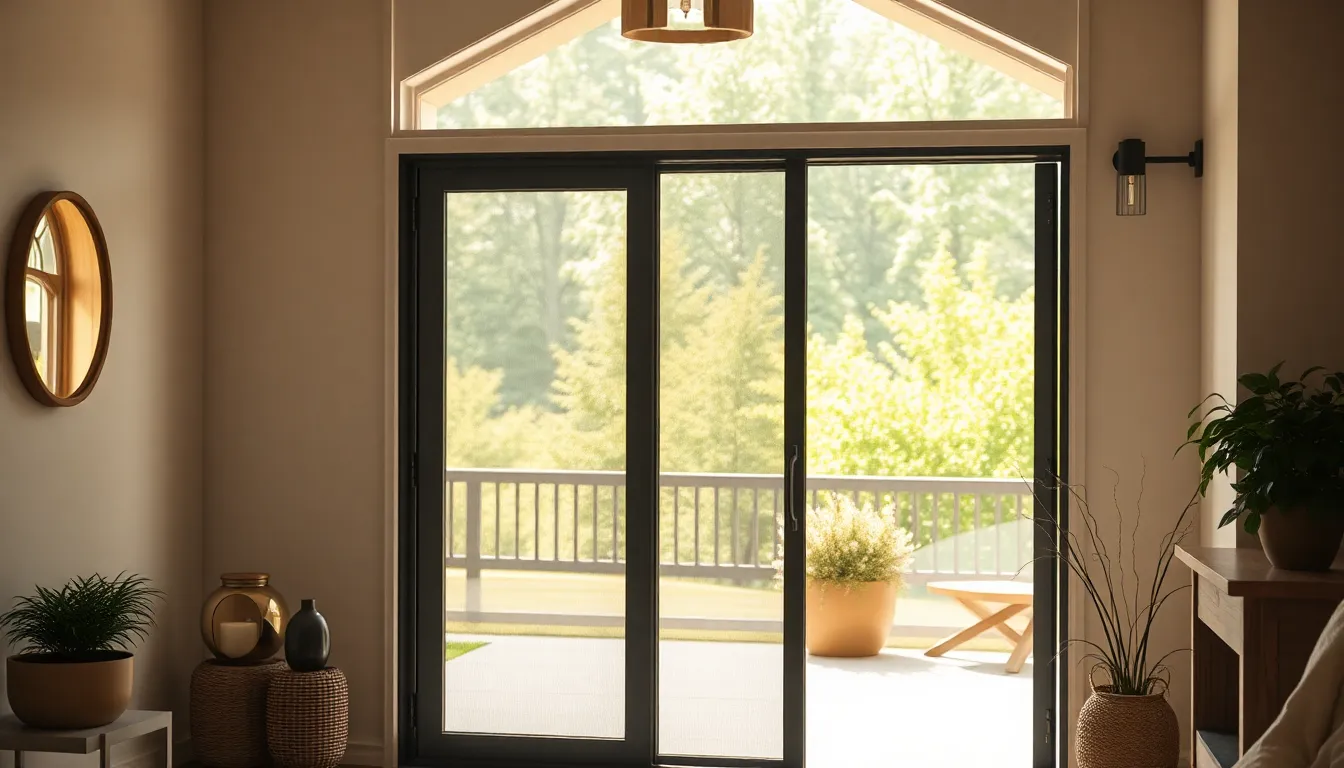Table of Contents
ToggleImagine a world where pesky bugs are kept at bay while fresh air flows freely into your home. Sounds dreamy, right? Enter the unsung hero of home improvement: the screen door. Not only does it add charm to your entryway, but it also transforms your living space into a bug-free oasis.
Understanding Screen Door Installation
Screen door installation involves several key steps and considerations. First, selecting the right type of screen door is essential. Options include retractable screen doors, sliding screen doors, and hinged screen doors. Each option serves specific purposes based on door types and user preferences.
Next, measuring the door frame accurately ensures a proper fit. Measure the height and width of the door opening, accounting for any obstructions such as hinges or handles. It’s advisable to take multiple measurements to confirm the dimensions.
After measurements are complete, preparing the door frame is vital. Clean the area where the screen door will attach, removing dust or debris. This preparation helps enhance the adhesion of the screen door frame.
Following preparation, installation can begin. Start by assembling the screen door according to the manufacturer’s instructions. Use a level to ensure alignment, securing the screen door with screws or brackets included in the installation kit.
Checking the screen door for smooth operation comes next. Open and close the door several times to ensure it works correctly. Adjustments may be necessary if any sticking or misalignment occurs.
Finally, maintain the screen door to extend its lifespan. Clean the screen regularly and check for wear or damage to the frame. Proper maintenance keeps entryways looking great while functioning effectively.
Understanding the installation process enables homeowners to ensure a seamless experience, enhancing both their living space and comfort.
Benefits of Installing a Screen Door

Installing a screen door offers numerous advantages for homeowners. These benefits enhance comfort, safety, and the overall functionality of living spaces.
Improved Airflow
Increased ventilation occurs with a screen door, allowing fresh air to flow throughout the home. Homeowners experience a comfortable environment while keeping living areas cool, especially during summer months. Properly installed screen doors reduce reliance on air conditioning, leading to lower energy bills. Additionally, inviting natural breezes minimizes stuffiness indoors. Enhancing air circulation contributes to a healthier atmosphere, which can improve overall well-being.
Insect Protection
Insect protection is a significant advantage of screen doors. They effectively keep bugs like mosquitoes and flies outside, ensuring a pest-free environment. Homeowners can enjoy open doors without worrying about unwanted guests. A screen door acts as a barrier that protects food and family from insects, especially during gatherings. Many screen doors come with durable mesh, designed to withstand wear and tear while providing transparency to enjoy views outside. Enhanced protection adds convenience and comfort to daily life.
Types of Screen Doors
Screen doors come in several types, each with unique features that suit different entryways and homeowner preferences. Understanding these options helps in making an informed choice for installation.
Hinged Screen Doors
Hinged screen doors attach to door frames much like standard exterior doors. They swing open and closed, offering ease of access. Homeowners appreciate their robust design, which generally handles heavy use well. Commonly found in traditional homes, these doors can match existing entry doors for added aesthetics. Installation requires sufficient space to ensure clear movement without obstruction. Materials range from wood to fiberglass, allowing flexibility in style.
Sliding Screen Doors
Sliding screen doors operate smoothly along a track, making them ideal for patios or large openings. They save space since they don’t require additional clearance to swing. Homeowners often favor them for their modern look and convenience. Aluminum or vinyl frames are common materials that enhance durability. Selecting a high-quality screen mesh maximizes ventilation while minimizing insect intrusion. Installation is straightforward, with alignment being key to smooth operation.
Tools and Materials Needed
Installing a screen door requires specific tools and materials to ensure a successful setup. Gather these essentials to streamline the installation process.
Essential Tools
- Drill/Driver: A power drill or screwdriver simplifies the process of securing screws.
- Measuring Tape: Accurate measurements prevent sizing issues during installation.
- Level: Using a level ensures the screen door hangs straight for optimal function.
- Utility Knife: A utility knife is handy for trimming excess material from the screen.
- Pliers: Pliers aid in bending or shaping any necessary components.
- Safety Glasses: These protect the eyes from debris while working on the door.
Recommended Materials
- Screen Door Kit: Ensure the kit is compatible with the door frame for easy installation.
- Screws: Use high-quality screws that fit the specific dimensions of the screen door.
- Weather Stripping: Weather stripping provides a tight seal that enhances energy efficiency.
- Mesh Screen: Choose durable mesh that withstands wear and allows for optimal airflow.
- Hinges or Track System: Select hinges for a hinged door or a track system for sliding doors based on preference.
- Paint or Stain: Use paint or stain to match the screen door with existing décor for a cohesive look.
Step-by-Step Installation Process
Following a clear installation process simplifies adding a screen door. Homeowners can enhance their entryway while improving ventilation and conserving energy.
Preparing the Door Frame
Start by measuring the door frame accurately, ensuring room for the screen door to fit without obstruction. Clean the frame thoroughly to eliminate dust or debris that can hinder adhesion. Use painter’s tape to mark exact locations for hinges and mounting brackets. It’s important to check for level and plumb alignment before proceeding. Adjust the frame as necessary, addressing any gaps or imperfections that could affect installation.
Installing the Screen Door
Attach hinges to the door first, ensuring they align with the marks made earlier. Position the screen door into the frame, carefully aligning it with the door frame edges. Securely fasten the hinges to the frame using screws, creating a stable connection. If opting for a sliding model, install the track system according to the manufacturer’s guidelines. Test the door’s operation after installation, ensuring it opens and closes smoothly. Fine-tune any misalignments as needed, maintaining even gaps along all edges for optimal functionality.
Common Mistakes to Avoid
Selecting the wrong type of screen door leads to inefficiencies. Homeowners often overlook door types, which can affect functionality and aesthetic appeal. Not measuring the door frame accurately results in installation challenges later on. Heeding measurements ensures a snug fit and minimizes gaps that could allow bugs inside.
Preparing the door frame is crucial for successful adhesion. Neglecting this step can lead to complications, such as improper alignments. Cleaning the frame thoroughly removes debris and adds to the screen door’s longevity. Ensuring the frame is free of dust and grime improves the adhesive bond.
Ignoring the manufacturer’s instructions frequently causes misalignments during installation. Following guidelines fosters a proper fit and efficient operation. Skipping the use of a level might lead to an uneven door, which can become cumbersome over time. Each setup should be checked for plumb alignment before securing any components.
Over-tightening screws can damage materials and lead to premature wear. Correctly tightening hardware strikes a balance between security and durability. Dismissing the importance of weather stripping allows drafts and bugs to enter the home. Properly applying weather stripping enhances insulation and keeps unwanted pests out.
Test the door’s operation after installation to ensure it’s functioning properly. Failing to do this might result in future malfunctions or misalignments. Lastly, overlooking maintenance can shorten the door’s lifespan. Regular checks and upkeep maintain its efficiency, safeguarding against pests and enhancing the overall living space.
Installing a screen door is a smart way to improve a home’s comfort and aesthetic appeal. By following the outlined steps and tips, homeowners can ensure a successful installation that enhances airflow while keeping unwanted pests at bay. Choosing the right type of screen door and using quality materials plays a crucial role in achieving long-lasting results.
Regular maintenance and proper operation checks will help extend the lifespan of the screen door, making it a valuable investment. With a little effort, homeowners can enjoy a more inviting and functional living space that balances fresh air with protection from insects.







